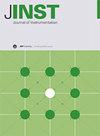The ATLAS experiment at the CERN Large Hadron Collider: a description of the detector configuration for Run 3
IF 1.3
4区 工程技术
Q3 INSTRUMENTS & INSTRUMENTATION
引用次数: 0
Abstract
The ATLAS detector is installed in its experimental cavern at Point 1 of the CERN Large Hadron Collider. During Run 2 of the LHC, a luminosity of ℒ = 2 × 1034 cm-2 s-1 was routinely achieved at the start of fills, twice the design luminosity. For Run 3, accelerator improvements, notably luminosity levelling, allow sustained running at an instantaneous luminosity of ℒ = 2 × 1034 cm-2 s-1, with an average of up to 60 interactions per bunch crossing. The ATLAS detector has been upgraded to recover Run 1 single-lepton trigger thresholds while operating comfortably under Run 3 sustained pileup conditions. A fourth pixel layer 3.3 cm from the beam axis was added before Run 2 to improve vertex reconstruction and b-tagging performance. New Liquid Argon Calorimeter digital trigger electronics, with corresponding upgrades to the Trigger and Data Acquisition system, take advantage of a factor of 10 finer granularity to improve triggering on electrons, photons, taus, and hadronic signatures through increased pileup rejection. The inner muon endcap wheels were replaced by New Small Wheels with Micromegas and small-strip Thin Gap Chamber detectors, providing both precision tracking and Level-1 Muon trigger functionality. Trigger coverage of the inner barrel muon layer near one endcap region was augmented with modules integrating new thin-gap resistive plate chambers and smaller-diameter drift-tube chambers. Tile Calorimeter scintillation counters were added to improve electron energy resolution and background rejection. Upgrades to Minimum Bias Trigger Scintillators and Forward Detectors improve luminosity monitoring and enable total proton-proton cross section, diffractive physics, and heavy ion measurements. These upgrades are all compatible with operation in the much harsher environment anticipated after the High-Luminosity upgrade of the LHC and are the first steps towards preparing ATLAS for the High-Luminosity upgrade of the LHC. This paper describes the Run 3 configuration of the ATLAS detector.欧洲核子研究中心大型强子对撞机上的 ATLAS 实验:运行 3 的探测器配置说明
ATLAS 探测器安装在欧洲核子研究中心大型强子对撞机 1 号点的实验洞穴中。在大型强子对撞机运行 2 期间,开始填料时的常规光度为 ℒ = 2 × 1034 cm-2 s-1,是设计光度的两倍。在运行 3 阶段,加速器的改进,特别是光度均衡化,使得瞬时光度ℒ = 2 × 1034 cm-2 s-1 的持续运行成为可能,每束交叉平均可发生多达 60 次相互作用。ATLAS 探测器已经升级,可以恢复运行 1 的单轻子触发阈值,同时在运行 3 的持续堆积条件下舒适地运行。在运行 2 之前,在距离束轴 3.3 厘米处增加了第四个像素层,以提高顶点重建和 b 标记性能。新的液氩量热计数字触发电子装置以及相应的触发和数据采集系统升级,通过提高堆叠抑制能力,利用 10 倍的细粒度改进了对电子、光子、太赫子和强子特征的触发。内μ介子端盖轮被新的小轮所取代,新的小轮配备了微型气体和小条薄间隙腔探测器,提供精确跟踪和一级μ介子触发功能。利用集成了新型薄间隙电阻板室和小直径漂移管室的模块,扩大了靠近一个端盖区域的内筒μ介子层的触发覆盖范围。增加了瓦片量热计闪烁计数器,以提高电子能量分辨率和背景抑制能力。对最小偏差触发闪烁器和正向探测器的升级改进了光度监测,并实现了质子-质子总截面、衍射物理和重离子测量。这些升级都与大型强子对撞机高亮度升级后预期的更恶劣环境下的运行兼容,是ATLAS为大型强子对撞机高亮度升级做好准备的第一步。本文介绍了ATLAS探测器的运行3配置。
本文章由计算机程序翻译,如有差异,请以英文原文为准。
求助全文
约1分钟内获得全文
求助全文
来源期刊

Journal of Instrumentation
工程技术-仪器仪表
CiteScore
2.40
自引率
15.40%
发文量
827
审稿时长
7.5 months
期刊介绍:
Journal of Instrumentation (JINST) covers major areas related to concepts and instrumentation in detector physics, accelerator science and associated experimental methods and techniques, theory, modelling and simulations. The main subject areas include.
-Accelerators: concepts, modelling, simulations and sources-
Instrumentation and hardware for accelerators: particles, synchrotron radiation, neutrons-
Detector physics: concepts, processes, methods, modelling and simulations-
Detectors, apparatus and methods for particle, astroparticle, nuclear, atomic, and molecular physics-
Instrumentation and methods for plasma research-
Methods and apparatus for astronomy and astrophysics-
Detectors, methods and apparatus for biomedical applications, life sciences and material research-
Instrumentation and techniques for medical imaging, diagnostics and therapy-
Instrumentation and techniques for dosimetry, monitoring and radiation damage-
Detectors, instrumentation and methods for non-destructive tests (NDT)-
Detector readout concepts, electronics and data acquisition methods-
Algorithms, software and data reduction methods-
Materials and associated technologies, etc.-
Engineering and technical issues.
JINST also includes a section dedicated to technical reports and instrumentation theses.
 求助内容:
求助内容: 应助结果提醒方式:
应助结果提醒方式:


